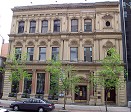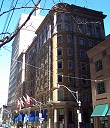Located on Toronto Street, the historic plaque reads: “In 1852 the Consumers’ Gas Company of Toronto established its new head office building on this site, in the prestigious financial district of the city. Expansion to the north in 1876 added a second building located at 19 Toronto Street, designed in the Renaissance style by architect David B. Dick, whose later alterations in 1899 unified the facades of both buildings. The company remained in this location for 125 years. Renovations, undertaken by Stone & Kohn architects, for Counsel Trust Company were completed in 1983.”
Located on King Street east of Yonge, the “King Eddie” was built at the turn of the last century and opened in 1903. It was built at a cost of 6 million dollars by George Gooderham, of Gooderham & Worts Distillery, who was at that time the richest man in Toronto. The building’s architect was E.J. Lennox, the man responsible for many of Toronto’s most magnificent edifices, including Casa Loma and Old City Hall. Over the years the King Edward’s guests have included royalty, world leaders and pop musicians, including the Beatles who stayed there in the mid-1960’s. In 1975 it was designated an historical site, and the building underwent a 25 million dollar facelift and restoration in 1979. Today the hotel operates as Le Royal Meridien King Edward Hotel, and is still considered one of Toronto’s grandest and most luxurious places to stay.
Located on the west side of Toronto Street across from the Consumers’ Gas Building, profiled above, the historic plaque reads: “Built 1851-1853 for The Province of Canada, the Seventh Post Office was designed by Toronto architects Frederic Cumberland and Thomas Ridout. The building in the then popular Neo-classical style, resembles a Greek temple. The elegant symmetry of the Ionic columns, corner piers, and the entablature topped with the Royal Arms of England demonstrates an ease with classical forms. The building served as a post office till 1873, and housed government offices until 1937. It was then sold to the Bank of Canada and later purchased and refurbished by Argus Corporation Limited.
The south St. Lawrence Market building at King and Jarvis Streets began life as Toronto’s second City Hall. Designed in 1844 by architect Henry Bowyer Lane, the building housed the council chamber and municipal offices on the second floor, Police
Station #1 on the main floor, jail cells in the basement, and a market area in the rear. Over the latter half of the 19th century as the city grew, various alterations were made to the building, but by the late 1800’s it was clear that the space was no longer adequate. The civic offices were transferred to the “new” City Hall at Bay and Queen in 1899, and the vacated building was radically altered to provide a larger market for the city. The central portion of the original building survives today as part of the south St. Lawrence Market, seen here. The second floor houses the Market Gallery of the City of Toronto Archives, which occupies the original council chamber.
Located at Yonge and Front Streets, The Hockey Hall of Fame occupies the 1885 Bank of Montreal building. Darling and Curry, the architects, also designed the Victoria Hospital for Sick Children on College Street. The 1885 building replaced a smaller one of 1845, and was the head office of the bank in Toronto. After the second world war a new head branch was opened at King and Bay. The Yonge and Front branch continued in business until 1982, when it closed. In the late 1980’s as part of the BCE place development, the building was restored and renovated, and opened as the Hockey Hall of Fame in 1993.
When Lieutenant Governor John Graves Simcoe arrived at the future site of Toronto in 1793, one of his first priorities was to construct a military garrison. With the help of the Queen’s Rangers, the Loyalist Regiment he commanded in the Revolutionary War, he did so on a site two miles west of the original Town of York. Simcoe left York before long, but his instincts about the American threat were accurate, and American troops invaded and occupied York twice during the War of 1812, destroying most of the original fort in the process. After the war the fort was rebuilt, but fell into disrepair towards the end of the 19th century, particularly after a new garrison was built west of the original fort in 1841. In 1909 the city bought the fort and restored it between 1932-34 as part of Toronto’s centennial celebrations. The present buildings at Fort York are a combination of restored original structures from the 1813-15 period and replica buildings.



